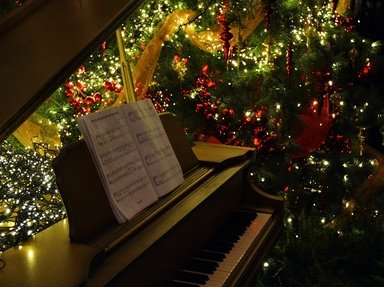Quiz Answer Key and Fun Facts
1. "Deck the Halls With Boughs of Holly" is one of the most frequently heard carols around the holidays. Ironically, it was not originally a Christmas carol. It originated in Wales, was entitled "Nos Galan" and had lyrics which bear almost no resemblance to those of "Deck the Halls". For what holiday was "Nos Galan" originally sung?
2. "Jingle Bells" is, without question, the most ubiquitous of Christmas carols, at least in America. It is heard countless times each year on television, radio, and in canned holiday music for elevators, shopping centers and the like. It was originally penned in 1857 by James Pierpont and was performed at a Sunday School children's programme; for which holiday was it originally written?
3. In the 19th century, Santa Claus (a.k.a. St. Nicholas or St. Nick) became a feature of Christmastime in Europe and America. Around the time of the Civil War, two American songs appeared which celebrated this tradition; one was "Jolly Old St. Nicholas", by an anonymous composer & lyricist. The other was known to have been written by Benjamin Russell Hanby, a poet and minister who was active in the Underground Railroad. Which of these carols did Hanby pen?
4. "Oh Tannenbaum" ("Oh Christmas Tree") has a long and varied history. The melody has been used in the U.S. on several occasions for state songs. Which state still uses the melody of "O Tannenbaum" for its state song?
5. There are innumerable "Wassail songs" from almost all parts of England. The best-known to most people, particularly in the U.S., is "Here We come a-Wassailing". What does "Wassail" mean?
6. According to the "New Oxford Book of Carols", this favorite tune was used as an "envoi" as wassailers traveled from one home to the next. Which of these songs is it?
7. In "The Twelve Days of Christmas", the "five gold rings" may originally have been five turkeys.
8. This Yuletide favorite was composed for the 1942 movie "Holiday Inn", although a later movie was actually named after it. For fifty years (until 1998), the first recording of this song held the record as the best-selling single in any music category.
9. This Yuletide favorite was written by Jay Livingston and Ray Evans for the 1951 film "The Lemon Drop Kid", starring Bob Hope. It was sung as a duet between Hope and Marilyn Maxwell.
10. Which of these popular favorites was composed by the legendary popular singer Mel Torme?
11. "Rudolph the Red Nosed Reindeer" began, not as a song, but as a children's coloring book.
12. This song was written in 1943 by lyricist James Kimball Gannon and composer Walter Kent. Appearing during the darkest days of WWII, it expressed the hopes and dreams of servicemen and their families.
13. "Have Yourself a Merry Little Christmas" was written by Hugh Martin and Ralph Blane for the 1944 film "Meet Me in St. Louis", starring Judy Garland, Tom Drake, Marjorie Main, Mary Astor, and Margaret O'Brien. Blane credited Ms. Garland with playing an important part in improving the lyrics of this song.
14. I am including this piece among the secular carols since the text generally used for it contains no strictly religious lyrics, although some versions include the line "Jesus is born!" It began as a New Year's choral piece by the Ukranian composer Mykola Leontovich entitled "Shchedryk", which was eventually rearranged with new lyrics by the American composer and choral director Peter Wilhousky. The words to which it is currently sung bear no resemblance to the original text.
15. This song was penned by Meredith Willson, best known as the composer/lyricist of "The Music Man" and "The Unsinkable Molly Brown". It was written in 1951 and was featured in the 1963 Broadway show "Here's Love", a musical version of "Miracle on 34th Street".
Source: Author
jouen58
This quiz was reviewed by FunTrivia editor
minch before going online.
Any errors found in FunTrivia content are routinely corrected through our feedback system.

